Caribbean Regiment
The Caribbean Regiment (also known as the Carib Regiment) was a regiment of the British Army during the Second World War. The regiment went overseas in July 1944 and saw service in the Middle East and Italy.
| Caribbean Regiment | |
|---|---|
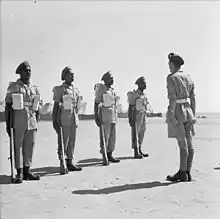 Caribbean Regiment soldiers in Egypt | |
| Active | 1944–1946 |
| Country | United Kingdom |
| Branch | |
| Type | Infantry |
| Engagements | World War II |
There had been resistance from the War Office to form the West Indian regiment, but those who made their own way to the UK were able to enlist in the British Army. Nearly 10,000 British West Indians travelled and joined the army in Britain.
Following discussion between the Colonial Office and the War Office, the Caribbean Regiment was formed in April 1944 of 1,200 volunteers. The recruits were drawn from all over the British West Indies; most were members of local Volunteer Defence Forces. A few officers and non-commissioned Officers were also drafted in from British Army units.
A detachment of 104 officers and men from the North Atlantic island of Bermuda (where two British Army reserve units raised in the 1890s, the Bermuda Militia Artillery and the Bermuda Volunteer Rifle Corps, had been joined in the 1930s by the Bermuda Volunteer Engineers and Bermuda Militia Infantry, all mobilised for full-time service as parts of the Bermuda Garrison at the start of the war), made up of volunteers (conscription had been introduced to Bermuda shortly after the declaration of war, but those who were drafted to the Caribbean Regiment volunteered to do so) from the Bermuda Militia Artillery and Bermuda Militia Infantry, arrived on two ships on 13 and 23 April 1944 to form the training cadre of the new regiment at Fort Eustis, a US Army base near Williamsburg, Virginia. Under the command of Lt. Colonel H. Wilkin, OBE, MC, they prepared for the arrival of detachments from the West Indian islands, each under its own officers. Newly recruited men were tested in Virginia for fitness. With more experience, and a generally higher degree of education, many of the Bermudian men were made non-commissioned officers and distributed around the regiment.
Some of the Caribbean soldiers had already trained for deployment to the Pacific. The Bermudians had previously trained within the Bermuda Garrison for the war in Europe. The new regiment trained in Virginia, where the regiment was the first to celebrate the King's birthday in the U.S. since the American Revolution.
The Regiment left the USA for Oran, in North Africa, in June 1944. Oran was handed over to Free French Forces before their arrival, and the Regiment went on to Italy in July 1944, where it was employed in general duties behind the front line. In October, it escorted 4,000 German prisoners of war from Italy to Egypt, where it was used in mine clearance work around the Suez Canal area.
The regiment never saw front line action. This was due partly to inadequate training (with only a single battalion, it had not trained as part of a larger brigade; the smallest unit the British Army normally fielded on its own) and partly because of the anticipated political impact in the British West Indies if heavy casualties had been incurred.
In 1946, it returned to the West Indies and was disbanded.
Gallery
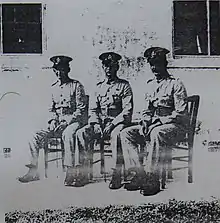 Bermudian CSM Edward A. Lee (right) of the Caribbean Regiment circa 1940, during his earlier service with the Bermuda Volunteer Rifle Corps.
Bermudian CSM Edward A. Lee (right) of the Caribbean Regiment circa 1940, during his earlier service with the Bermuda Volunteer Rifle Corps.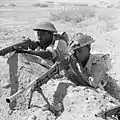 1st Battalion, Caribbean Regiment soldiers armed with a Lee-Enfield No. 4 rifle and Bren light machine gun training in Egypt in 1945
1st Battalion, Caribbean Regiment soldiers armed with a Lee-Enfield No. 4 rifle and Bren light machine gun training in Egypt in 1945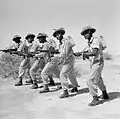 1st Battalion, Caribbean Regiment soldiers train with the Thompson submachine gun in Egypt in 1945
1st Battalion, Caribbean Regiment soldiers train with the Thompson submachine gun in Egypt in 1945 1st Battalion, Caribbean Regiment soldiers training in Egypt rush from a Universal carrier to take up position with a Bren gun in 1945
1st Battalion, Caribbean Regiment soldiers training in Egypt rush from a Universal carrier to take up position with a Bren gun in 1945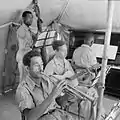 1st Battalion, Caribbean Regiment dance band in Egypt in 1945
1st Battalion, Caribbean Regiment dance band in Egypt in 1945